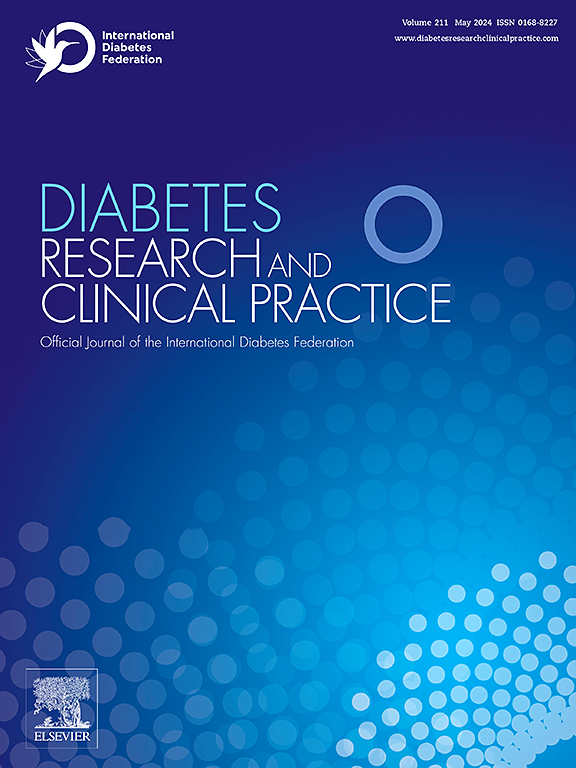The effectiveness of continuous glucose monitoring with remote telemonitoring-enabled virtual educator visits in adults with non-insulin dependent type 2 diabetes: A randomized trial
IF 6.1
3区 医学
Q1 ENDOCRINOLOGY & METABOLISM
引用次数: 0
Abstract
Aims
Estimate the effectiveness of continuous glucose monitoring (CGM) with remote telemonitoring-enabled virtual diabetes educator visits for improving glycemic management in adults with type 2 diabetes, not on insulin.
Methods
Participants with type 2 diabetes, not on insulin, and HbA1c > 7.0 % were enrolled in an open-label randomized trial of 6 weeks of CGM with telemonitoring versus enhanced usual care. Both groups received educator visits. HbA1c was assessed at 12 weeks.
Results
Of 105 participants (mean age 57.3 years, 49.5 % females, mean baseline HbA1c 8.0 %), 86 remained at follow-up. Change in HbA1c was −0.69 % (CGM) versus −0.33 % (enhanced usual care). Adjusting for baseline HbA1c, CGM was superior (0.65 % greater HbA1c reduction [95 % CI 0.17–1.12 %], p = 0.008). CGM participants were 92 % (RR = 1.92, 1.19–3.06, p = 0.007) more likely to have an HbA1c reduction ≥ 0.5 %, lost more weight (difference in weight reduction 2.17 kg, 0.22–4.11, p = 0.029) and were more satisfied with their treatment. No treatment-related adverse events were observed.
Conclusions
CGM with virtual diabetes educator visits is effective, safe, and acceptable in adults with type 2 diabetes not on insulin and should be considered as an alternative to drug therapy for improving blood glucose.
对非胰岛素依赖型 2 型糖尿病成人患者进行持续葡萄糖监测和远程远程监测虚拟教育访问的有效性:随机试验。
目的:评估连续血糖监测(CGM)与远程远程监测支持的虚拟糖尿病教育访问对改善未使用胰岛素的成人 2 型糖尿病患者血糖管理的效果:未使用胰岛素且 HbA1c > 7.0 % 的 2 型糖尿病患者参加了一项为期 6 周的远程监控 CGM 与强化常规护理的开放标签随机试验。两组患者都接受了教育工作者的访问。12 周后对 HbA1c 进行评估:在 105 名参与者(平均年龄 57.3 岁,49.5% 为女性,平均 HbA1c 基线值为 8.0%)中,有 86 人继续接受随访。HbA1c的变化率为-0.69%(CGM)与-0.33%(强化常规护理)。调整基线 HbA1c 后,CGM 更胜一筹(HbA1c 下降率增加了 0.65 % [95 % CI 0.17-1.12%],p = 0.008)。没有观察到与治疗相关的不良事件:结论:对于未使用胰岛素的成人 2 型糖尿病患者来说,带有虚拟糖尿病教育者访问的 CGM 是有效、安全和可接受的,应被视为改善血糖的药物治疗替代方法。
本文章由计算机程序翻译,如有差异,请以英文原文为准。
求助全文
约1分钟内获得全文
求助全文
来源期刊

Diabetes research and clinical practice
医学-内分泌学与代谢
CiteScore
10.30
自引率
3.90%
发文量
862
审稿时长
32 days
期刊介绍:
Diabetes Research and Clinical Practice is an international journal for health-care providers and clinically oriented researchers that publishes high-quality original research articles and expert reviews in diabetes and related areas. The role of the journal is to provide a venue for dissemination of knowledge and discussion of topics related to diabetes clinical research and patient care. Topics of focus include translational science, genetics, immunology, nutrition, psychosocial research, epidemiology, prevention, socio-economic research, complications, new treatments, technologies and therapy.
 求助内容:
求助内容: 应助结果提醒方式:
应助结果提醒方式:


